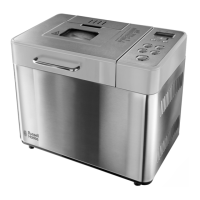7
the range of 20°C - 25°C. It will slow the yeast if it is too hot or cold. Don’t use milk with the delay
timer; it might curdle before the bread-making process starts.
Fats and oils. These include butter and olive oil. They make the dough more tender and
enhance the avour, giving the nished loaf a richer quality. They help to retain moisture,
making the bread keep fresh longer. Don’t use low fat spread.
Sugar. Sugar activates and feeds the yeast, allowing it to grow. It adds avour and texture, and
helps with browning the crust. Honey, syrup, or molasses may be used instead of sugar,
provided the liquid ingredient is adjusted to compensate. Don’t use articial sweeteners. None
of them will feed the yeast and some of them may kill it.
Salt. Salt helps to control the growth of the yeast, preventing the bread from rising too much or
collapsing. It also adds to the avour. Salt may inhibit the yeast if it is too strong, so keep them
separate when adding the ingredients.
Eggs. Eggs are used in some recipes to make your bread richer and more nutritious, add colour,
and help with the structure and texture. Eggs count as part of the liquid ingredient of the bread.
Adjust the other liquid ingredients if you are adding them. Otherwise the dough may be too wet
to rise properly.
Herbs and spices. Dried herbs and spices like cinnamon, ginger, oregano, parsley, and basil will
add avour and interest. These can be added at the beginning, along with the main ingredients.
Fresh herbs, like garlic and chives may contain enough liquid to upset the balance of the recipe,
so the liquid content must be adjusted accordingly.
Nuts, raisins and other ingredients. These should be added to the dispenser before pressing
the Start button. The Breadmaker will beep when it adds them at the correct part of the
program. Dried fruit and nuts should be chopped nely; cheese should be grated. Fresh fruit
and nuts contain liquids (juices and oils), so you may need to adjust the main liquid ingredient to
compensate.
Adding ingredients
Remove the bread pan from the breadmaker using the Handle to pull it
straight up and out of the machine.
Make sure the bread pan is completely clean and the t the paddle to the
shaft at the bottom.
It’s important that you add the ingredients in the correct order,
particularly if you are using the delay timer. If the yeast gets wet, it may
activate too early in the process.
Liquid ingredients, including milk and
eggs, should be added rst, followed by
the our and other dry ingredients (see
diagram).
Add salt to the liquid to avoid it coming in contact with the yeast.
Make a small indentation on the top of the our and add the yeast
here. This will prevent the liquid from coming in contact with the
yeast.
Important. Your bread maker will bake up to a 1kg loaf. Do not
put larger quantities of ingredients into the bread pan. The bread will not mix and bake
correctly, and bread maker may be damaged.
Dry
Yeast
Liquid

